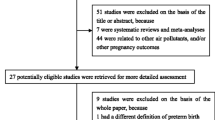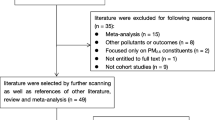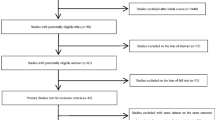Abstract
The previous studies estimated the association between PM2.5 (particulate matter with aerodynamic diameter less than or equal to 2.5 μm) exposure during pregnancy and preterm birth, only considered and highlighted the hazard effects of high levels of air pollutant exposure, and underestimated that low levels of pollutant exposure might also affect pregnancy outcome. We conducted a meta-analysis of 11 cohort studies, a total of more than 1,500,000 subjects. The results of these studies were pooled by exposure levels and study periods. PM2.5 exposure during pregnancy was positively associated with preterm birth (OR = 1.15, 95% CI = 1.07–1.23), and during the first trimester of pregnancy, low levels of PM2.5 exposure were also positively associated with preterm birth (OR = 1.17, 95% CI = 1.04–1.30). It is important to protect pregnant women from PM2.5 exposures, especially during their first trimester of pregnancy even when the ambient PM2.5 concentration is relatively low. More relevant health policy should be carried out to prevent hazard effect of air pollutants.





Similar content being viewed by others
References
Bosetti C, Nieuwenhuijsen MJ et al (2010) Ambient particulate matter and preterm birth or birth weight: a review of the literature. Arch Toxicol 84(6):447–460
Brauer M, Lencar C et al (2008) A cohort study of traffic-related air pollution impacts on birth outcomes. Environ Health Perspect 116(5):680–686
Cha J, Bartos A et al (2013) Combinatory approaches prevent preterm birth profoundly exacerbated by gene-environment interactions. J Clin Investig 123(9):4063–4075
Chen Y, Mi BB et al (2016) Prenatal exposure to outdoor air pollution and preterm birth: a Meta-analysis. Chin J Epidemiol 37(6):880–885
Cormier SA, Ye X et al (2016) Acute effects of particulate air pollution on the incidence of coronary heart disease in Shanghai, China. PLoS One 11(3):e0151119
DeFranco E, Moravec W et al (2016) Exposure to airborne particulate matter during pregnancy is associated with preterm birth: a population-based cohort study. Environ Health 15(1)
DerSimonian R, Laird N (2015) Meta-analysis in clinical trials revisited. Contemp Clin Trials 45:139–145
DeVries R, Kriebel D et al (2016) Low level air pollution and exacerbation of existing COPD: a case crossover analysis. Environ Health 15(1)
Fleischer NL, Merialdi M et al (2014) Outdoor air pollution, preterm birth, and low birth weight: analysis of the World Health Organization global survey on maternal and perinatal health. Environ Health Perspect 122(4):425–151
Gehring U, Wijga AH et al (2011) Traffic-related air pollution, preterm birth and term birth weight in the PIAMA birth cohort study. Environ Res 111(1):125–135
Gent JF, Triche EW et al (2003) Association of low-level ozone and fine particles with respiratory symptoms in children with asthma. JAMA 290(14):1859–1867
GK S (2012) Preterm birth, a known risk factor for infant and childhood death, is an independent risk factor for mortality in early childhood and young adulthood. Evid Based Med 17:121–122
Glinianaia SV, Rankin J et al (2004) Particulate air pollution and fetal health. Epidemiology 15(1):36–45
Ha S, Hu H et al (2014) The effects of air pollution on adverse birth outcomes. Environ Res 134:198–204
Hannam K, McNamee R et al (2014) Air pollution exposure and adverse pregnancy outcomes in a large UK birth cohort: use of a novel spatio-temporal modelling technique. Scand J Work Environ Health 40(5):518–530
Hatala R (2005) Tips for learners of evidence-based medicine: 4. Assessing heterogeneity of primary studies in systematic reviews and whether to combine their results. Can Med Assoc J 172(5):661–665
Heo J, Schauer JJ et al (2014) Fine particle air pollution and mortality. Epidemiology 25(3):379–388
Huttunen K, Siponen T et al (2012) Low-level exposure to ambient particulate matter is associated with systemic inflammation in ischemic heart disease patients. Environ Res 116:44–51
Jalaludin B, Mannes T et al (2007) Impact of ambient air pollution on gestational age is modified by season in Sydney, Australia. Environ Health 6(1)
Jedrychowski W, Bendkowska I et al (2004) Estimated risk for altered fetal growth resulting from exposure to fine particles during pregnancy: an epidemiologic prospective cohort study in Poland. Environ Health Perspect 112(14):1398–1402
Jedrychowski W, Perera F et al (2009) Gender differences in fetal growth of newborns exposed prenatally to airborne fine particulate matter. Environ Res 109(4):447–456
Kannan S, Misra DP, Dvonch JT, Krishnakumar P et al (2006) Exposures to airborne particulate matter and adverse perinatal outcomes: a biologically plausible mechanistic framework for exploring potential effect modification by nutrition. Environ Health Perspect 114(11):1636–1642
Lamichhane DK, Leem J-H et al (2015) A meta-analysis of exposure to particulate matter and adverse birth outcomes. Environ Health Toxicol 30:e2015011
Lee P-C, Roberts JM et al (2012) First trimester exposure to ambient air pollution, pregnancy complications and adverse birth outcomes in Allegheny County, PA. Matern Child Health J 17(3):545–555
Liu J-P (2008) Design, implementation and methodological issues in cohort study. J Chin Integr Med 6(4):331–336
Maisonet M, Correa A et al (2004) A review of the literature on the effects of ambient air pollution on fetal growth. Environ Res 95(1):106–115
Matte T, Clougherty JE et al (2016) Ambient fine particulate matter, nitrogen dioxide, and preterm birth in New York City. Environ Health Perspect 124(8)
Nieuwenhuijsen MJ, Dadvand P, Grellier J, Martinez D, Vrijheid M (2013) Environmental risk factors of pregnancy outcomes: a summary of recent meta-analyses of epidemiological studies. Environ Health 12(6)
Pereira G, Belanger K et al (2013) Fine particulate matter and risk of preterm birth in Connecticut in 2000-2006: a longitudinal study. Am J Epidemiol 179(1):67–74
Pereira G, Bell ML et al (2014) Fine particulate matter and risk of preterm birth and pre-labor rupture of membranes in Perth, Western Australia 1997–2007: a longitudinal study. Environ Int 73:143–149
Pereira G, Evans KA et al (2016) Fine particulates, preterm birth, and membrane rupture in Rochester, NY. Epidemiology 27(1):66–73
Poirier A, Dodds L et al (2015) Maternal exposure to air pollution and adverse birth outcomes in Halifax, Nova Scotia. J Occup Environ Med 57(12):1291–1298
Qian Z-M, Liang S-W et al (2016a) Ambient air pollution and preterm birth: a prospective birth cohort study in Wuhan, China. Int J Hyg Environ Health 219(2):195–203
Qian N-S, Yu H-T et al (2016b) Association between maternal air pollution exposure during first trimester and birth weight in Shanghai. J Occup Environ Med 33(9):827–832
Ritz B, Wilhelm M et al (2007) Ambient air pollution and preterm birth in the environment and pregnancy outcomes study at the University of California, Los Angeles. Am J Epidemiol 166(9):1045–1052
Romero R, Dey SK et al (2014a) Preterm labor: one syndrome, many causes. Science 345(6198):760–765
Romero R, Miranda J et al (2014b) Prevalence and clinical significance of sterile intra-amniotic inflammation in patients with preterm labor and intact membranes. Am J Reprod Immunol 72(5):458–474
Sapkota A, Chelikowsky AP et al (2010) Exposure to particulate matter and adverse birth outcomes: a comprehensive review and meta-analysis. Air Qual Atmos Health 5(4):369–381
Shi L, Zanobetti A, Kloog I, Coull BA, Koutrakis P et al (2015) Low-Concentration PM2.5 and Mortality: Estimating Acute and Chronic Effects in a Population-Based Study. Environ Health Perspect 124(1):46–52
Šrám RJ, Binková B et al (2005) Ambient air pollution and pregnancy outcomes: a review of the literature. Environ Health Perspect 113(4):375–382
Stieb DM, Chen L, Eshoul M, Judek S (2012) Ambient air pollution, birth weight and preterm birth: a systematic review and meta-analysis. Environ Res 117:100–111
Stroup DF (2000) Meta-analysis of observational studies in epidemiology: a proposal for reporting. JAMA 283(15):2008
Sun X-L, Luo X-P et al (2015) The association between fine particulate matter exposure during pregnancy and preterm birth: a meta-analysis. BMC Pregnancy Childbirth 15(1)
Wang J-J, Zhao A-L et al (2009) Impact of air pollution on low birth weight and preterm birth: a meta-analysis. J Environ Health 26(9):795–798
Wegorzewska M, Nijagal A et al (2014) Fetal intervention increases maternal T cell awareness of the foreign conceptus and can lead to immune-mediated fetal demise. J Immunol 192(4):1938–1945
Laurent O, Hu J, Li L, Kleeman MJ, Bartell SM et al (2016) A Statewide Nested Case–Control Study of Preterm Birth and Air Pollution by Source and Composition: California, 2001–2008. Environ Health Perspect 124(9):1479–1486
Xu D-Z (2008) Research design of clinical medicine research. Chin J Pract Pediatr 23(3):237–240
Zeng X-T, Liu H et al (2012) Meta-analysis: quality assessment tools of observational study. Chin J Evid Based Cardiovasc Med 4(4):297–299
Zhang L, Zhang Y et al (2015) Characteristics of atmospheric PM2.5 and the variation of PAHs in PM2.5 during spring in Hongshan district, Wuhan. China Environ Sci 35(8):2319–2325
Zhu X-X, Liu Y et al (2014) Maternal exposure to fine particulate matter (PM2.5) and pregnancy outcomes: a meta-analysis. Environ Sci Pollut Res 22(5):3383–3396
Author information
Authors and Affiliations
Corresponding authors
Ethics declarations
Funding
The study was funded by the Hubei Province Health and Family Planning Scientific Research Project (WJ2015MA027) and the National Natural Science Foundation of China (no. 91543207).
Conflict of interest
The authors declare that they have no conflict of interest.
Additional information
Responsible editor: Philippe Garrigues
Rights and permissions
About this article
Cite this article
Liu, C., Sun, J., Liu, Y. et al. Different exposure levels of fine particulate matter and preterm birth: a meta-analysis based on cohort studies. Environ Sci Pollut Res 24, 17976–17984 (2017). https://doi.org/10.1007/s11356-017-9363-0
Received:
Accepted:
Published:
Issue Date:
DOI: https://doi.org/10.1007/s11356-017-9363-0




